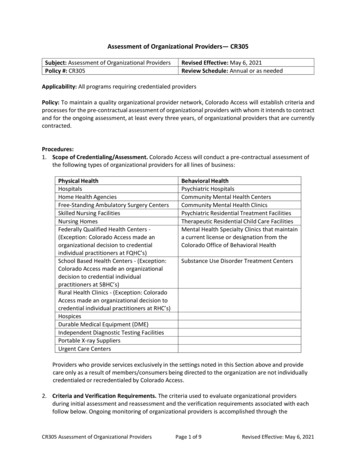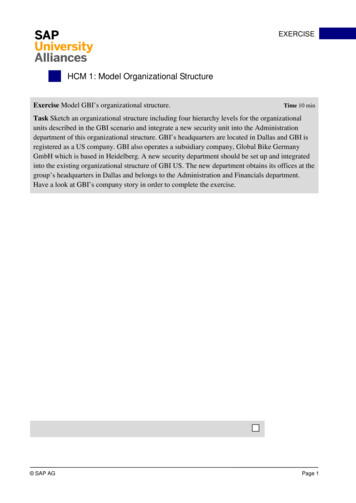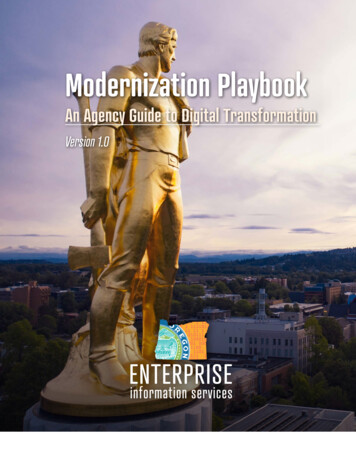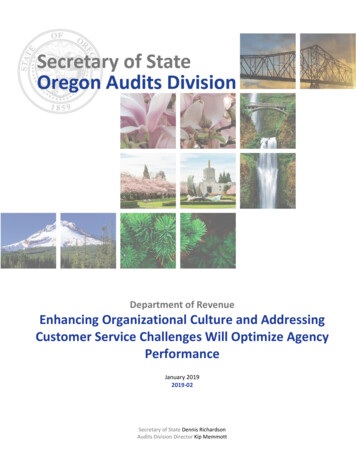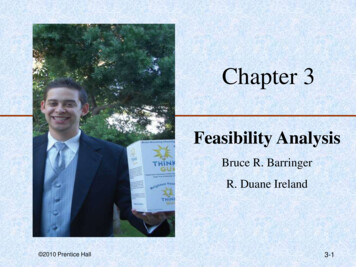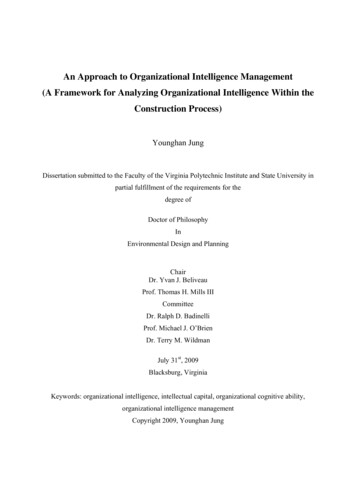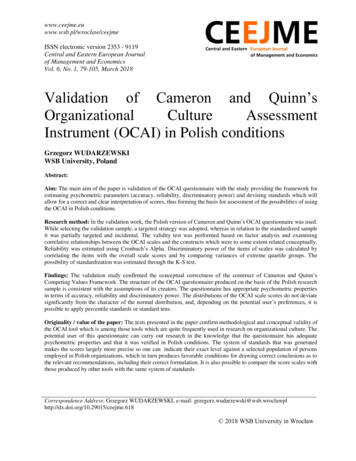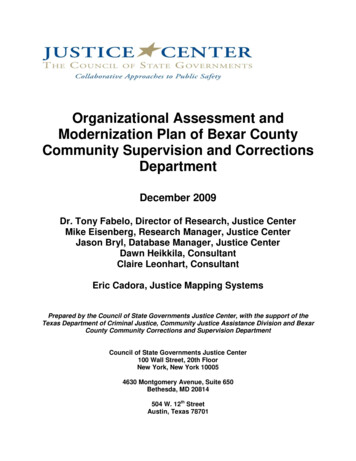
Transcription
Organizational Assessment andModernization Plan of Bexar CountyCommunity Supervision and CorrectionsDepartmentDecember 2009Dr. Tony Fabelo, Director of Research, Justice CenterMike Eisenberg, Research Manager, Justice CenterJason Bryl, Database Manager, Justice CenterDawn Heikkila, ConsultantClaire Leonhart, ConsultantEric Cadora, Justice Mapping SystemsPrepared by the Council of State Governments Justice Center, with the support of theTexas Department of Criminal Justice, Community Justice Assistance Division and BexarCounty Community Corrections and Supervision DepartmentCouncil of State Governments Justice Center100 Wall Street, 20th FloorNew York, New York 100054630 Montgomery Avenue, Suite 650Bethesda, MD 20814504 W. 12th StreetAustin, Texas 78701
This project was supported by the Texas Department of Criminal Justice, CommunityJustice Assistance Division and the Bexar County Community Corrections and SupervisionDepartment. Points of view or opinions in this document are those of the authors and do notrepresent the official position of the sponsors.The Council of State Governments Justice Center is a national nonprofit organizationthat serves policymakers at the local, state, and federal levels from all branches of government.The Justice Center provides practical, nonpartisan advice and consensus-driven strategies,informed by available evidence, to increase public safety and strengthen communities.The Justice Center‟s board of directors includes state legislative leaders, judges, adultand juvenile corrections administrators, directors of behavioral health agencies, lawenforcement professionals and representatives of the victim community; together, theyrepresent a cross-section of individuals who shape criminal justice public policies in the stateand nation.CSG is a nonpartisan, nonprofit organization that seeks to foster excellence in stategovernment. Founded in 1933, CSG serves the executive, judicial and legislative branches ofstate government through leadership education, research and information services. The Councilof State Governments is our nation‟s only organization serving all three branches of stategovernment. CSG is a region-based forum that fosters the exchange of insights and ideas tohelp state officials shape public policy. This offers unparalleled regional, national andinternational opportunities to network, develop leaders, collaborate and create problem-solvingpartnerships (see: www.csg.org and www.justicecenter.org.csg).Council of State Governments, Justice Center 2009 by The Council of State Governments Justice CenterAll rights reserved. Published 2009
Organizational Assessment andModernization Plan of Bexar CountyCommunity Supervision and CorrectionsDepartmentDecember 2009Dr. Tony Fabelo, Director of Research, Justice CenterMike Eisenberg, Research Manager, Justice CenterJason Bryl, Database Manager, Justice CenterDawn Heikkila, ConsultantClaire Leonhart, ConsultantEric Cadora, Justice Mapping CenterCouncil of State Governments Justice Center100 Wall Street, 20th FloorNew York, New York 100054630 Montgomery Avenue, Suite 650Bethesda, MD 20814504 W. 12th StreetAustin, Texas 78701
AcknowledgementsThe Justice Center assessment team would like to acknowledge the full cooperation ofDirector, Bill Fitzgerald and his executive staff, Minerva Boor, Robert Edwards, Wade Lewis,Lisa Mobley, Frances Rendon, Kathy Cline, Sharon Raymond, Leticia Esquivel, MaryMoncivais, Andrea Ramirez and Aimee Sharp. They facilitated all aspects of the assessment.We would also like to acknowledge the department‟s staff who so willingly participated ininterviews and focus groups and the judges that gave us time from their busy schedule to talk tous. Finally, the Bexar County District Attorney, Susan Reed, and the Bexar District and CountyJudges need to be acknowledged for their commitment to support this assessment and considerthe recommendations for improving the Bexar County probation system presented here.
Table of ContentsExecutive Summary . viI. Introduction . 1A. Background .1B. Assessment Methodology .2C. Basic Facts about Bexar CSCD .3II. Evidence-Based Practices Model . 8A. Elements of the Model .8III. Overview of Findings: Bexar CSCD as Organization in Need of Modernization .13A. Overview of Findings.13B. Roots of the Dysfunctional Operation .18C. Unmanageable Complexity .24D. Inconsistent Supervision Practices.28E. Pre-sentence Investigation Process .37F. Specialized Programs and Residential Treatment Capacity .42G. Computerized Case Management Systems .45H. Other Areas for Review .48I. Recent Organizational Turmoil .49IV. Pre-sentence Investigations and Probation Intake Process .51A. Overview .51B. Processing from Arrest to Pre-Sentence Investigations .51C. PSI Unit, PSI Format and Intake Process .53D. Impact of Lack of Case Management System .56E. Workload of PSI Unit .62F. Process Inefficiencies Highlighted by Focus Groups .63V. Supervision Strategies .66A. Overview .66B. Impact of Variations by Courts .66C. Supervision Plans and Progressive Sanctions .81VI. Mapping Analysis.88VII. Review of Personnel Evaluation and Training Policies .94A. Overview .94B. Personnel Hiring and Turnover Rate .94C. Personnel Evaluation Policies .97i
D. Training Policies and Procedures. 102E. Observations Regarding Personnel Evaluations . 106F. Observations Regarding Training . 107G. Observations Regarding the Organization . 108H. Recommendations . 109VIII. Public Safety Outcomes.112A. Overview . 112B. Revocation Trends . 113C. Re-arrests Rates, Jail Population and Crime Rates . 118IX. Recommendations and Work Plan to Implement Improvements .122A. Major Findings and Recommendations . 122B. Work Plan . 123C. Timelines . 127ii
Table of TablesTable 1: Organizational Assessment Areas . 2Table 2: Population under Direct Probation Supervision in Ten Largest Community Supervisionand Corrections Departments (CSCDs) in Texas, August 2008 . 4Table 3: Total Number of Probationers under Direct Supervision in Bexar CSCD, . 4Table 4: Offense Distribution of Persons under Direct Probation Supervision in Bexar CSCD,FY 2008 . 5Table 5: State and Local Funding of the Bexar CSCD, Fiscal Year 2005 - 2010 . 6Table 6: Number of Staff and Ratio of Staff to Probationers under Direct Supervision in SixLargest Probation Department in Texas, December 2008 . 7Table 7: Summary of Findings of Bexar CSCD EBP Organizational Assessment .16Table 8: Summary of Specialized and Residential Programs and Projected Number ofProbationers to be served in FY 2010-2011 .44Table 9: Bexar County CSCD PSI Applications Received by Category of PSI, January 2009June 2009 .54Table 10: PSI Officer Workload Study Results .62Table 11: Summary of Differences in Sanctioning Policies among Felony Courts .69Table 12: Example of Miscellaneous Policies among Felony Courts .73Table 13: Example of Miscellaneous Policies among Misdemeanor Courts .79Table 14: Summary of Cases Reviewed to Learn File Structure and Compliance Issues .82Table 15: Bexar County CSCD Starting Monthly Salaries, 2002-2009 .96Table 16: Length of Service of Bexar County CSCD Community Supervision Officers .96Table 17: Bexar County CSCD Staff Turnover Rates Calendar Years 2005 through 2008 .97Table 18: Community Supervision Officer Evaluation Categories .100Table 19: Bexar County CSCD Training Sessions Fiscal Year 2009 .105Table 20: Percent Distribution by Level of Supervision of Felons and Misdemeanants ReceivingDirect Probation Supervision in Five Largest Texas CSCDs, June 2009 .112Table 21: Felony and Misdemeanor Revocations in Five Largest Community Supervision andCorrections Departments (CSCDs) in Texas, FY 2005 - FY 2008 .113Table 22: Felony and Misdemeanor Revocation Rates in Five Most Populous Counties, FY2005 - FY 2008 .114Table 23: Felony and Misdemeanor Technical Revocations in Five Largest CommunitySupervision and Corrections Departments (CSCDs) in Texas, FY 2005 – FY 2008 .114Table 24: Felony and Misdemeanor Technical Revocation Rates in Five Most PopulousCounties, FY 2005 - FY 2008 .115Table 25: Felony Probation Revocations in Bexar CSCD and Dallas CSCD, 1999-2008 .115Table 26: Misdemeanor Probation Revocations in Bexar CSCD and Dallas CSCD, 1999-2008.116Table 27: Bexar County Jail Population, August 2000 to August 2009 .120Table 28: Population and Crime Rate Change in Texas Largest Cities, Crime Rate per 100,000Population .121iii
Table of FiguresFigure 1: Integration of Evidence-Based Practices Model Elements into a Cohesive OperationalModel .12Figure 2: Graphic Depiction of Historical Timeline of Bexar County Probation DepartmentAdministration .15Figure 3: Court and Probation Department Organizational Model to Support EBP Operations .19Figure 4: Depiction of the Court Assignment Probation System in Bexar County .21Figure 5: Comparison of Bexar County with Harris, Dallas, Travis, Lubbock and HidalgoCounties along Court – Probation Organization .22Figure 6: Texas Law Regarding Judicial Immunity in the Oversight Function of ProbationDepartments .23Figure 7: Depiction of Department‟s Four Supervision Operational Layers .25Figure 8: Recent Audits of the Bexar CSCD by the Texas Department of Criminal Justice,Justice Assistance Division .28Figure 9: Average Caseloads in Bexar CSCD and Expenditures per Case for Basic Supervisionfor Felonies and Misdemeanors .29Figure 10: Graphic Depiction of Court Policy Areas Related to the Supervision of Probationers.30Figure 11: Average Assessment of Fines, Court Fees, CAA and Supervisory Fees by CountyCourts for August 20, 2009 to September 9, 2009 .32Figure 12: Number of Sentence Extensions Granted by County Courts, 2008-2009 .33Figure 13: Fee and Fine Collection Process and Forms Used by Each District Court Setting theDistribution of Financial Obligations .35Figure 14: Graphic Depiction of “My Cousin‟s Problem” Related to Supervising Probations inthe Same Neighborhood under Different Policies .37Figure 15: Graphic Depiction of PSI Paperwork and Personnel Resources Dedicated toAssessing Probationers .38Figure 16: Travis County Centralized Diagnosis Assessment Report .40Figure 17: Travis County “Diagnosis Matrix” as Part of Assessment Report to the Courts .42Figure 18: Depiction of the Present Information System Structure of the Bexar ProbationDepartment and Summary of Benefits of a Case Management System .46Figure 19: Snapshot of Monthly Invoice to for Buying Paper for the Department .48Figure 20: Arrest to Court Proceeding .52Figure 21: Court Proceeding to Sentencing .53Figure 22: Depiction of Part of PSI Report and Source Documents Used as Part of PSI .55Figure 23: Sentencing to CSCD Intake.56Figure 24: Information Systems Utilized During Arrest to Orientation Process .58Figure 25: Summary of Arrest to Probation Intake Process and Highlight of Inefficiencies Due toLack of Computerized Case Management System .61Figure 26: Example of a Supervision Plan for Credit Card Abuse.84Figure 27: Structure of an EBP Supervision Plan .86Figure 28: Geographical Distribution of the Probation Population in Bexar County by ZIP CodeArea .89Figure 29: Geographical Distribution of Cases by for a Typical Regular Supervision Officer .90Figure 30: Deployment of Probation Officers in a Sample Neighborhood in Bexar County .91Figure 31: Depiction of Cases Reassigned by Geography in One ZIP Code .92iv
Figure 32: Potential Geographical Distribution of Caseloads Assuming Officers Were AssignedAlong a Neighborhood Supervision Model .93Figure 33: Recommended Concept for Matrix Instrument to be Developed and Adopted for theNew Personnel Evaluation System .110Figure 34: Percent of Cases Supervised under Minimum Supervision and Overall RevocationRate by District Courts, September 2008 – August 2009 .117Figure 35: One Year Re-arrest Rates by Risk Levels for Felons Placed under Supervision inBexar CSCD and Travis CSCD .118Figure 36: Two-Year Re-arrests Rates by Risk Levels for Misdemeanors Placed underSupervision in Bexar CSCD and Travis CSCD .119Figure 37: Overview of Main Findings, Recommendations and Implementation Timeline .123Figure 38: Timeline for Implementation of Case Management System .124Figure 39: Modernization of Intake and Case Assignment Process .125Figure 40: Tasks Related to the Development of Central Diagnosis Unit.126Figure 41: Other Areas of Implementation of Evidence-Based Practices.127Figure 42: Timeline for Modernization and EBP Organizational Model Implementation,December 2009-September 2010 .128Figure 43: Timeline for Modernization and EBP Organizational Model Implementation,September 2010-December 2011 .129v
Executive SummaryOn July 1, 2009 the Justice Center of the Council of State Governments (Justice Center)began assessing the Bexar County Community Supervision and Corrections Department (BexarCSCD) to determine how the department‟s operations measures against an Evidence-BasedPractice operational model (EBP). This assistance was requested by Bill Fitzgerald, Director ofthe Bexar CSCD in early 2009. The main goal of EBP is to operate probation departments as“learning organizations” that use strategies proven to be effective to manage the probationpopulation and reduce recidivism. EBP emphasizes differentiated supervision strategies basedon risks and needs of the population.This report presents the results of the organizational assessment conducted to identifythe challenges facing the Bexar CSCD in implementing this model and presentsrecommendations to address these challenges. The assessment team spent over 50 persondays on site interviewing personnel, visiting facilities, assessing documents and makingpresentations as appropriate. Nearly one-third of the department‟s personnel were interviewedindividually or in groups as part of this process (123 interviews). In addition, data were collectedfrom various sources including the county‟s computer system and the state computerizedprobation records system (Community Supervision Tracking System or CSTS). Site visits wereconducted to all residential programs including site visits to other Bexar County programs.The assessment team was headed by Dr. Tony Fabelo, former director of the TexasCriminal Justice Policy Council and Director of Research for the Justice Center. The teamincluded experts in recidivism and risk analysis (Mike Eisenberg), data management (JasonBryl), probation supervision (Claire Leonhart), and personnel and training (Dawn Heikkila).Mapping analyses were conducted by Eric Cadora, director of the Justice Mapping Systems.The findings of the assessment team, the suggested work plan and the department‟sstrategic plan were presented by Dr. Fabelo to all the managers of the probation department onNovember 5, 2009 and to all department staff on November 12, 2009. Dr. Fabelo followed-upwith presentations to the Bexar District Attorney and County Court judges on November 17,2009 and to selected County Commissioners on November 18, 2009 and to the District Courtjudges on November 19, 2009. A written summary of the report was given to the judicialofficials during these briefings. This summary was then presented to the San Antonio NewsExpress Editorial Board meeting on November 30, 2009 by Dr. Fabelo and Bexar CountySenators Jeff Wentworth and Leticia Van de Putte. The participation of the senators reflects theimportance that state officials place in the improvements of this department.The effectiveness of the Bexar CSCD is of great significance to the state criminal justicesystem due to the size of the department and the amount of state resources it consumes. BexarCounty is the fourth most populous county in the state and San Antonio is the seventh mostpopulous city in the country with a population of 1,351,305. Bexar CSCD is responsible for thethird largest probation population under supervision in the state (20,268), representing over 7%of the probationers in Texas. The state provides approximately 67% of the funding for thedepartment with the rest of the funding generated by probationer fees. Between 2005 and 2008the state funding for the department was over 57 million. State funding increased by 37%during this period while locally collected fees stayed about the same. The total state fundingduring 2005 and 2010 is projected to be over 88 million.vi
The assessment shows Bexar CSCD is an organization in need of modernization. Thedepartment is operating in an environment more reminiscent of how probation departmentsoperated in the past than how they operate today. This is reflected, among other indicators, inthe obsolete “court assignment probation structure” in which each court controls their ownofficers and managers and offenders placed on probation in a court are only supervised by theprobation officers assigned to that court. As a result of this form of organization the departmentcannot effectively deploy caseloads based on consistent risk and criminogenic needs policies.Other areas of inefficiencies include: a) a fragmented assessment process; b) lack of a unifiedcourt policy related to supervision and sanctioning strategies; c) lack of outcome measures toguide policies; d) lack of a computerized case management system; and, e) poor training andpersonnel evaluation policies.This assessment was not intended to uncover “savings” but a cursory examination ofcosts shows that over 1 million could be “saved” or redirected by reforming the departmentalong EBP. Making better use of managers and officers assigned to each court, eliminating thepractice of supervising the same person on felony and misdemeanor probation using twodifferent officers, re-designing the PSI process to reduce duplication, reducing turnover ofprobation officers by having an effective career ladder system and improving processes andaccountability with a case management system should generate those savings. Additionalsavings can be generated by having better outcomes. For example, reducing revocations willreduce the number of jail bed days used for this population which will reduce jail costs. Finally,improving reporting of workload information to the state would generate close to 300,000 inadditional state revenue that was lost last year due to the misreporting of this information.Line probation officers are aware of the EBP model in general and have indicated theywould like to adopt some of these practices if the organization would support them. However,the issues mentioned above create overwhelming barriers for them. It is important to note thatthere are some judges that are eager to move forward by modernizing the department and arewilling to change the “court assignment probation system” in which each court essentially runsits own probation department. During briefings conducted in November 2009 there appeared tobe a general understanding that the department needs to be modernized. Bexar is the onlylarge county in Texas operating under this “court assignment system” and the judges realizenegative probation outcomes indicate that this is not the most effective way to organize amodern probation department. Moreover, the judges are increasingly aware that under thepresent organizational structure they are exposed to claims of administrative acts that exposethem to personal liabilities.In 2005 the legislature amended the Government Code to clarify the three areas inwhich judges have oversight responsibility for probation departments. These are: (a)establishing a community supervision and corrections department; (b) approve the department‟sbudget and community justice plan; and (c) hire and fire the department‟s director and the ChiefBudget Officer of the department. Other activities dealing with the operation of the probationdepartment are considered “administrative acts” and for these acts there is no immunity againstpersonal liability. Effective since 2005, this law also allows County Court Judges to participatein the decision to hire and fire a probation chief, which was previously the exclusive decision ofthe District Court judges.The 2005 legal changes emanated from a personal liability lawsuit against a judge inTarrant County related to claims of liability for administrative decisions. The manner in whichthe Bexar CSCD is operated exposes judges to claims they are making administrativevii
decisions. Conversations with focus groups revealed various examples which, under the rightlitigious circumstances, judges may be exposed to personal liability for administrative acts.Bexar County has only one reporting location for probationers, the main building locatedin downtown San Antonio. This does not facilitate effective supervision practices and thedeployment of personnel. The probation population in Bexar County is spread over a significantgeographical area. Over 350 probationers reside in each of 14 ZIP codes, some a significantdistrance from the main probation office. Unlike Bexar County, Harris, Dallas and TravisCounties provide probationers with multiple locations to report across the county.The deployment of cases along each court “probation system” leads to inefficient andineffective use of supervision resources, particularly with only one reporting location. Forexample, as shown below, 595 probationers were being supervised by 113 different probationofficers responding to 22 different courts in a single neighborhood (defined as a ZIP code).Given the present size of the caseloads in the department, these same probationers could besupervised by six officers dedicated to that same area. This would maximize the use ofresources and allow for better supervision. Officers can learn the neighborhood, the resourcesavailable there to assist the probationers and also learn about criminogenic forces in the areathat can negatively impact the success of the supervision practices.viii
Deployment of Probation Officers in a Sample Neighborhood in Bexar County595 Felony a
Table 19: Bexar County CSCD Training Sessions Fiscal Year 2009 .105 Table 20: Percent Distribution by Level of Supervision of Felons and Misdemeanants Receiving Direct Probation Supervision in Five Largest Texas CSCDs, June 2009 .112 Table 21: Felony and Misdemeanor Revocations in Five Largest Community Supervision and .

